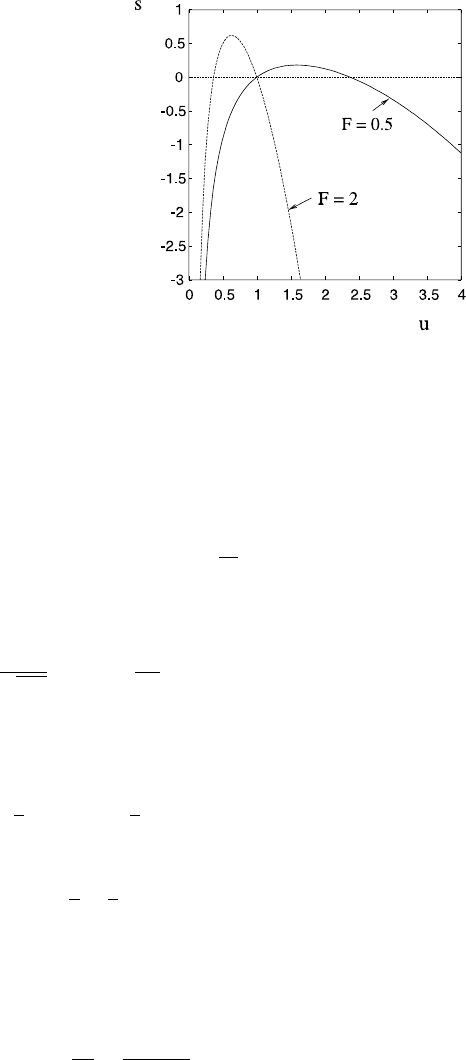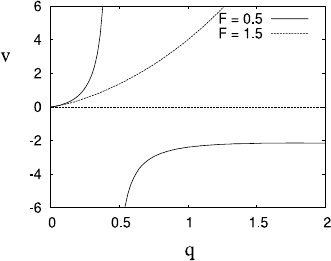Fowler A. Mathematical Geoscience
Подождите немного. Документ загружается.


280 5 Dunes
Fig. 5.10 s(u) as given by
(5.36) for two typical cases of
rapid and tranquil flow
and we choose h
0
,u
0
by balancing terms as follows: uh ∼ Q
0
, gS ∼fu
2
/h; here
Q
0
is the (prescribed) volume flow per unit width. We choose q
0
as the size of the
bedload transport equation in (5.5).
With these scales, the dimensionless equations corresponding to (5.31)are
s
t
+q
x
=0,
εh
t
+(uh)
x
=0,
F
2
(εu
t
+uu
x
) =−η
x
+δ
1 −
u
2
h
,
h =η −s,
(5.33)
where the parameters are
F =
u
0
√
gh
0
,ε=
q
0
Q
0
,δ=S. (5.34)
If we now suppose ε 1 and δ 1, both of them realistic assumptions, then we
have approximately
uh = 1,
1
2
F
2
u
2
+η =
1
2
F
2
+1,
(5.35)
supposing that u, h →1 at large distances. Eliminating h and η,wehave
s =1 −
1
u
+
1
2
F
2
1 −u
2
, (5.36)
whose form is shown in Fig. 5.10. In particular, s
(1) = (1 −F
2
), so the basic state
u =1 corresponds to the left hand or right hand root of s(u) depending on whether
the Froude number F<1orF>1.
We also have
ds
dη
=
F
2
−h
3
F
2
, (5.37)

5.4 St. Venant Type Models 281
Fig. 5.11 The wave speed
v(q) =3q
4/3
/(1 −F
2
q) for
the tranquil and rapid cases
F =0.5andF =1.5
so that small perturbations to h =1 are out of phase (dunes) if F<1 and in phase
(anti-dunes) if F>1. If we take the dimensionless bedload transport as q ≈τ
3/2
=
u
3
(the dimensionless basal stress having been scaled with fρ
w
u
2
0
), so that u =q
1/3
,
then we see from (5.36) that s = s(q), and s(q) has the same shape as s(u),asshown
in Fig. 5.10.
The whole model reduces to the single first order equation
s
(q)q
t
+q
x
=0. (5.38)
Disturbances to the uniform state q = 1 will propagate at speed v(q) = 1/s
(q),
where v isshowninFig.5.11.ForF<1, v(1)>0 and v
(1)>0, thus waves in q
(and thus s) propagate downstream and form forward-facing shocks; this is nicely
consistent with dunes. For F>1, v<0 and v
(1) is positive if F<2, negative if
F>2 (see Question 5.4). Backward-facing shocks form, these are elevations in s if
v
> 0.
Unfortunately, the hyperbolic equation does not admit instability. It is straight-
forward to insert a lag as before, by writing q(x,t) =q[s(x −δ,t)], or equivalently
s(x,t) =s[q(x +δ,t)]. Perturbation of
s
t
+q
x
=0,
q =q
s(x −δ,t)
,
(5.39)
via
s =¯se
ikx+σt
,q=1 +¯qe
ikx+σt
, (5.40)
leads to
σ ¯s +ik ¯q =0,
¯q =q
e
−ikδ
¯s,
(5.41)
and thus
σ =kq
[−sin kδ −i coskδ]. (5.42)
This requires sinkδ < 0 for instability if q
(s) > 0 (F < 1) and sinkδ > 0ifq
(s) <
0 (F > 1). The long wavelength limit of (5.26) in which kh →0 is precisely (5.42),
bearing in mind that (5.26) is dimensional and that q
=dq/du there, whereas q
=
dq/ds in (5.42).

282 5 Dunes
5.5 A Suspended Sediment Model
The shortcoming of both the potential model and the St. Venant/Exner model is the
lack of a genuine instability mechanism. We now show that the inclusion of sus-
pended load can produce instability. Ideally, we would hope to predict anti-dunes,
since dunes certainly do not require suspended sediment transport. A St. Venant
model including both bedload and suspended sediment transport is
h
t
+(uh)
x
=0,
u
t
+uu
x
=g(S −η
x
) −
fu
2
h
,
∂
∂t
(hc) +
∂
∂x
(hcu) =ρ
s
(v
E
−v
D
),
(1 −n)
∂s
∂t
+
∂q
b
∂x
=−(v
E
−v
D
),
(5.43)
where c is the column average concentration (mass per unit volume) of suspended
sediment (written as ¯c earlier). The distinction between suspended sediment trans-
port and bedload lies in the source terms due to erosion and deposition, v
E
and
v
D
, and it is these which may enable instability to occur. We have η −s = h, and
we suppose q
b
=q
b
(τ ), τ =fρ
w
u
2
, whence q = q(u). Additionally (see (5.7) and
(5.10)), we write
v
E
=v
s
E, ρ
s
v
D
=v
s
cD, (5.44)
and expect that E = E(u) and D = D(u), with E
> 0, D
< 0; typically E<1,
D>1.
We scale (5.43) as before in (5.32), except that we choose the time scale t
0
,
downstream length scale x
0
, and concentration scale c
0
via
c
0
=ρ
s
E
0
D
0
,t
0
=
(1 −n)h
0
v
s
E
0
,x
0
=
Q
0
v
s
D
0
, (5.45)
where we write
E =E
0
E
∗
(u/u
0
), D =D
0
D
∗
(u/u
0
), (5.46)
and choose E
0
and D
0
so that E
∗
and D
∗
are O(1), and so that these are consistent
with typical observed suspended loads of 10 g l
−1
. With this choice of scales, we
obtain the dimensionless set of equations
η −s =h,
εh
t
+(uh)
x
=0,
F
2
(εu
t
+uu
x
) =δ
1 −
u
2
h
−η
x
,
h(εc
t
+uc
x
) =E
∗
−cD
∗
,
s
t
+βq
x
=−(E
∗
−cD
∗
),
(5.47)

5.5 A Suspended Sediment Model 283
where the parameters ε, F, δ and β are now given by
ε =
E
0
(1 −n)D
0
=
c
0
ρ
s
(1 −n)
,δ=
u
0
S
v
s
D
0
,
F =
u
0
(gh
0
)
1/2
,β=
q
b0
D
0
Q
0
E
0
=
ρ
s
q
b0
c
0
Q
0
.
(5.48)
Here q
b0
is the scale for q
b
rather than q = q
b
/(1 − n). The Froude number is
the same as before, but the parameters ε and δ are different: ε is a measure of
the suspended sediment density relative to the bed density, and is always small;
δ is the ratio of the (small) bed slope to the ratio of settling velocity to stream
velocity. For more rapidly flowing streams, we might expect δ ∼1. However, if we
suppose that wavelengths of anti-dunes are comparable to the depth (so x
0
∼ h
0
),
then (5.45) implies δ ∼S 1. Thus δ ∼1 implies x
0
∼h
0
/S h
0
. The parameter
β is a direct measure of the ratio of bedload (ρ
s
q
b0
) to suspended load (c
0
Q
0
).For
β 1, we would revert to our preceding bedload model and its scaling, and neglect
the suspended load. If we adopt the Meyer-Peter/Müller relation in (5.5) and (5.6),
then (noting that fu
2
0
=gSh
0
)
q
b0
=
Kρ
l
ρ
(ghS)
3/2
, (5.49)
and we can write
β =
Kρ
l
(1 −n)ρ
S
3/2
εF
; (5.50)
both small or large values are possible.
To analyse (5.47), we ignore bedload (put β =0) and take ε →0. Then
η =h +s, uh =1, (5.51)
so that
c
x
=E
∗
(u) −cD
∗
(u) =−s
t
,
∂
∂x
1
2
F
2
u
2
+
1
u
+s
=δ
1 −u
3
.
(5.52)
If, in addition, δ 1, then, taking s =0 when h =1,
s =s(u) =
1
2
F
2
1 −u
2
+1 −
1
u
, (5.53)
and the entire suspended load model is
s
(u)
∂u
∂t
=cD
∗
(u) −E
∗
(u) =−
∂c
∂x
. (5.54)
The function s(u) is the same as we derived before in (5.36) and shown in
Fig. 5.10. We can in fact write (5.54) as a single equation for u, by eliminating c;
this gives
c =
E
∗
(u)
D
∗
(u)
+
s
(u)
D
∗
(u)
∂u
∂t
,
s
(u)
∂u
∂t
+
∂
∂x
E
∗
(u)
D
∗
(u)
+
s
(u)
D
∗
(u)
∂u
∂t
=0,
(5.55)

284 5 Dunes
and the equation for u (or the pair for u, c) is of hyperbolic type. Note that natural
initial boundary conditions for (5.54) are to prescribe u at t = 0, x>0, and c at
x =0, t>0.
Let us examine the stability of the steady state u =1, c =1. We put
u =1 +Re
Ue
ikx+σt
,c=1 +Re
Ce
ikx+σt
, (5.56)
and linearise, to obtain (noting E
∗
(1) =D
∗
(1) =1)
ikC =
E
∗
(1) −D
∗
(1)
U −C =−σs
(1), (5.57)
and thus
σ =
E
∗
(1) −D
∗
(1)
s
(1)
−k
2
−ik
1 +k
2
. (5.58)
If we suppose E
∗
> 0, D
∗
< 0 as previously suggested, then this model im-
plies instability (Re σ>0) for s
(1)<0, i.e. F>1, and that the wave speed is
−Im(σ )/k < 0; thus this theory predicts upstream-migrating anti-dunes.
Two features suggest that the model is not well-posed if F>1. The first is the
instability of arbitrarily small wavelength perturbations; the second is that the un-
stable waves propagate upstream, although the natural boundary condition for c is
prescribed at x =0.
Numerical solutions of (5.54) are consistent with these observations. In solving
the nonlinear model (5.54)in0<x<∞, we note that
d
dt
∞
0
s(u)dx =−[c]
∞
0
, (5.59)
which simply represents the net erosion of the bed downwards if the sediment flux
at infinity is greater than at zero. It thus makes sense to fix the initial boundary
conditions so that
c =1onx =0,
u →1asx →∞,t=0.
(5.60)
For F<1, numerical solutions are smooth and approach the stable solution
u =c =1. However, the solutions are numerically unstable for F>1, and u rapidly
blows up, causing breakdown of the solution.
Some further insight into this is gained by consideration of the solution at x =0.
If c =c
0
(t) on x = 0 and u = u
0
(x) on t =0, then we can obtain u on x = 0 from
(5.55), by solving the ordinary differential equation
∂u
∂t
+
E
∗
(u)
s
(u)
=
D
∗
(u)
s
(u)
c
0
(t) (5.61)
with u =u
0
(0) at t =0. If we suppose that c =1atx =0, then it is easy to show that
if F<1 and u(0, 0)<1/F
2/3
, then u(0,t)→ 1ast →∞. If on the other hand,
F>1 and u(0, 0)<1, then u(0,t)→1/F
2/3
in finite time, and the solution breaks
down as ∂u/∂t →∞;ifu(0, 0)>1, then u(0,t)→∞, again in finite time if, for
example, E
∗
∝u
3
. More generally, breakdown of the solution when F>1 occurs in
one of these ways at some positive value of x. Thus this suspended sediment model
shares the same weakness of the phase shift model in not appearing to provide a
well-posed nonlinear model.

5.6 Eddy Viscosity Model 285
5.6 Eddy Viscosity Model
The relative failure of the models above to explain dune and anti-dune formation
led to the consideration of a full fluid flow model, in which, rather than suppos-
ing that the flow is shear free and that viscous effects were confined to a turbulent
boundary layer, rotational effects were considered, and a model of turbulent shear
flow incorporating an eddy viscosity, together with the Exner equation for bedload
transport, was adopted. This allows for a linear stability analysis of the uniform flow
over a flat bed via the solution of a suitable Orr–Sommerfeld equation. We shall in
fact proceed in somewhat more generality. As an observation, fully-formed dunes
have relatively small height to length ratios, and thus the fluid flow over them can
be approximately linearised. Although we use a linear approximation to derive the
stress at the bed, we may retain the nonlinear Exner equation for example. In this
way we may derive a nonlinear evolution equation for bed elevation.
5.6.1 Orr–Sommerfeld Equation
Suppose, therefore, that we have two-dimensional turbulent flow down a slope of
gradient S, governed by the Reynolds equations
u
t
+uu
x
+wu
z
=−
1
ρ
∂p
∂x
+ν
T
∇
2
u +gS,
w
t
+uw
x
+ww
z
=−
1
ρ
∂p
∂z
+ν
T
∇
2
w −g
1 −S
2
1/2
,
u
x
+w
z
=0,
(5.62)
where (u, w) are the velocity components and ν
T
is an eddy viscosity associated
with the Reynolds stress terms, such as prescribed in (B.9). In the second equation,
we can take g(1 −S
2
)
1/2
≈g since S is small.
We consider perturbations to a basic shear flow u(z) in s<z<ηwhich satisfies
(5.62) with ν
T
taken as constant. (Later, we will study a more realistic eddy viscosity
model.) It is convenient first of all to non-dimensionalise the Eqs. (5.62). In the basic
uniform state, with s =0 and η =
¯
h, the shear flow satisfies
ν
T
∂u
∂z
=gS(
¯
h −z), (5.63)
whence
u =
gS
ν
T
¯
hz −
1
2
z
2
, (5.64)
and the column mean flow is
¯u =
1
¯
h
¯
h
0
udz=
gS
3ν
T
¯
h
2
. (5.65)

286 5 Dunes
Taking ν
T
=ε
T
¯u
¯
h, we find that the basal shear stress is
τ =ρ
w
ν
T
∂u
∂z
0
=fρ
w
¯u
2
, (5.66)
where f = 3ε
T
. This gives the relationship between the empirical f and the semi-
analytic ε
T
. If the bed and hence the flow is perturbed, we would only retain constant
ν
T
if the volume flux per unit width is the same; this we therefore assume.
We now non-dimensionalise the variables by writing
(u, w) ∼¯u, (x, z) ∼
¯
h, t ∼
¯
h/ ¯u, p −ρg(
¯
h −z) ∼ρ
w
¯u
2
. (5.67)
The dimensionless equations are
u
t
+uu
x
+wu
z
=−p
x
+
1
R
∇
2
u +
S
F
2
,
w
t
+uw
x
+ww
z
=−p
z
+
1
R
∇
2
w,
u
x
+w
z
=0,
(5.68)
and the parameters are a turbulent Reynolds number and the Froude number:
R =
¯u
¯
h
ν
T
,F=
¯u
g
¯
h
. (5.69)
The dimensionless basic velocity profile is then
u =
gS
¯
h
2
ν
T
¯u
z −
1
2
z
2
, (5.70)
and the dimensionless mean velocity is, by definition of ¯u,
1 =
gS
¯
h
2
3ν
T
¯u
. (5.71)
Since
ν
T
=ε
T
¯u
¯
h =
1
3
f ¯u
¯
h, (5.72)
this requires
¯u =
gS
¯
h
f
1/2
. (5.73)
In particular, the dimensionless basic velocity profile is
u =U(z)=3
z −
1
2
z
2
. (5.74)
We now suppose that s and η are perturbed by small amounts; we may thus
linearise (5.68). We put
(u, w) =
U(z)+ψ
z
, −ψ
x
, (5.75)

5.6 Eddy Viscosity Model 287
whence it follows for small ψ that ψ satisfies the steady state Orr–Sommerfeld
equation
U∇
2
ψ
x
−U
ψ
x
=R
−1
∇
4
ψ, (5.76)
where we assume stationary solutions in view of the anticipated fact that s evolves
on a slower time scale.
The condition of zero pressure at z =η is linearised to be
η =1 +F
2
p
z=1
. (5.77)
If F
2
is small, then we may take η to be constant, and we do so as we are primarily
interested in dunes. However, the dimensionless pressure p is only determined up
to addition of an arbitrary constant, which implies that the value of the constant η
is unconstrained. This represents the vertical translation invariance of the system. If
a uniform perturbation to s is made, then the response of the (uniform) stream is to
raise the surface by the same amount. We can remove the ambiguity by prescribing
η =1, with the implication that the mean value of s is required to be zero.
The other boundary conditions on z = s and z = 1 are no slip at the base, no
shear stress at the top, and the perturbed volume flux is zero. These imply
ψ =0,ψ
zz
=0onz =1,
s
0
U(z)dz+ψ =0,U+ψ
z
=0onz =s.
(5.78)
Linearisation of this second pair about z =0gives
ψ =0,ψ
z
=−U
0
s on z =0, (5.79)
where U
0
=U
(0). Our aim is now to solve (5.76) with (5.78) and (5.79) to calculate
the perturbed shear stress. The dimensional basal shear stress is then
τ =ρ
w
ε
T
¯u
2
U
0
1 +s
U
0
U
0
+
1
U
0
ψ
zz
|
0
, (5.80)
and since f =3ε
T
=ε
T
U
0
, we may write this as
τ =fρ
w
¯u
2
1 +
sU
0
U
0
+
1
U
0
ψ
zz
|
0
. (5.81)
The problem to solve for ψ is linear and inhomogeneous, and so we suppose that
s =
∞
−∞
ˆs(k)e
ikx
dk, ψ =
∞
−∞
ˆ
ψ(k)e
ikx
dk. (5.82)
(Note that ˆs will evolve slowly in time.) For each wave number k, we obtain
ik
U
ˆ
ψ
−k
2
ˆ
ψ
−U
ˆ
ψ
=
1
R
ˆ
ψ
iv
−2k
2
ˆ
ψ
+k
4
ˆ
ψ
, (5.83)
with boundary conditions
ˆ
ψ =
ˆ
ψ
=0onz =1,
ˆ
ψ =0,
ˆ
ψ
=−U
0
ˆs on z =0,
(5.84)

288 5 Dunes
and thus we finally define
ˆ
ψ =−U
0
ˆsΨ (z, k), (5.85)
where Ψ satisfies the canonical problem
ik
U
Ψ
−k
2
Ψ
−U
Ψ
=
1
R
Ψ
iv
−2k
2
Ψ
+k
4
Ψ
,
Ψ =Ψ
=0onz =1,
Ψ =0,Ψ
=1onz =0.
(5.86)
In terms of Ψ , the basal (dimensional) shear stress is
τ =fρ
w
¯u
2
1 −s −
∞
−∞
e
ikx
ˆs(k)Ψ
(0,k)dk
. (5.87)
Using the convolution theorem, this is
τ =fρ
w
¯u
2
1 −s +
∞
−∞
K(x −ξ)s
(ξ) dξ
, (5.88)
where s
=∂s/∂x, and
K(x) =−
1
2π
∞
−∞
Ψ
(0,k)
ik
e
ikx
dk. (5.89)
Depending on K, we can see how τ may depend on displaced values of s. The form
of (5.88) illustrates our previous discussion of the vertical translation invariance of
the system. For a possible uniform perturbation s = constant, we would obtain a
modification to the basic friction law, τ =fρ
w
¯u
2
. This is excluded by enforcing the
condition that s has zero mean in x,
lim
L→∞
1
2L
L
−L
s(x)dx =0, (5.90)
which corresponds (for a periodic bed) to prescribing
ˆs(0) =0. (5.91)
To determine K, we need to know the solution of (5.86) for all k. In general,
the problem requires numerical solution. However, note that R =1/ε
T
, and is rea-
sonably large (for a value f = 0.005, R =3/f =600). This suggests that a useful
means of solving (5.86) may be asymptotically, in the limit of large R. The fact that
we can obtain analytic expressions for Ψ
(0,k) means this is useful even when R
is not dramatically large, as here.
The solution of the Orr–Sommerfeld equation at large R has a long pedigree, and
it is a complicated but mathematically interesting problem. We devote Appendix C
to finding the solution. We find there that, for k>0,
Ψ
(0,k)≈−3(ikRU
0
)
1/3
Ai(0) +O(1), (5.92)
where Ai is the Airy function. For k<0, Ψ
(0,k)= Ψ
(0, −k), and this leads to
Ψ
(0,k)
ik
≈
−ce
−iπ/3
|k|
−2/3
,k>0,
−ce
iπ/3
|k|
−2/3
,k<0,
(5.93)

5.6 Eddy Viscosity Model 289
where
c =3(RU
0
)
1/3
Ai(0), (5.94)
and c ≈1.54R
1/3
for U
0
=3, as Ai(0) =
1
3
2/3
(
2
3
)
≈0.355. From (5.89), we find
K(x) =
c
π
∞
0
cos
kx −
π
3
dk
k
2/3
. (5.95)
Evaluating the integral,
3
we obtain the simple formula
K(x) =
μ
x
1/3
,x>0,
K(x) =0,x<0,
(5.96)
where
μ =
3
2/3
R
1/3
2
3
2
≈1.13R
1/3
. (5.97)
For stability purposes, note that
K =
∞
−∞
ˆ
K(k)e
ikx
dk, (5.98)
where
ˆ
K =−
Ψ
(0,k)
2πik
=
c exp
−
iπ
3
sgnk
2π|k|
2/3
. (5.99)
5.6.2 Orr–Sommerfeld–Exner Model
We now reconsider (5.33), which we can write in the form
s
t
+q
x
=0,
εh
t
+(uh)
x
=0,
F
2
(εu
t
+uu
x
) =−η
x
+δ
1 −
τ
h
,
h =η −s.
(5.100)
Here τ is the local basal stress, scaled with fρ
w
u
2
0
. We suppose q = q(τ), so that
the Exner equation is
∂s
∂t
+q
(τ )
∂τ
∂x
=0. (5.101)
3
How do we do that? The blunt approach is to consult Gradshteyn and Ryzhik (1980), where the
relevant formulae are on page 420 and 421 (items 4 and 9 of Sect. 3.761). The quicker way, using
complex analysis, is to evaluate
∞
0
θ
ν−1
e
iθ
dθ (after a simple rescaling of k, k|x|=θ )byrotating
the contour by π/2 and using Jordan’s lemma. Thus
∞
0
θ
ν−1
e
iθ
dθ =(ν)e
iπν/2
.
